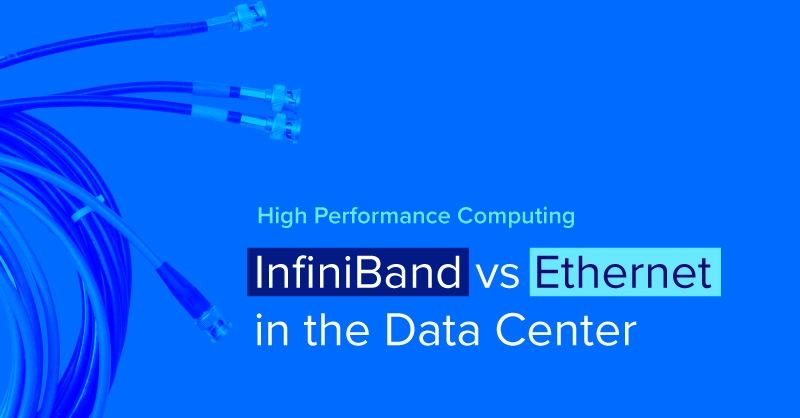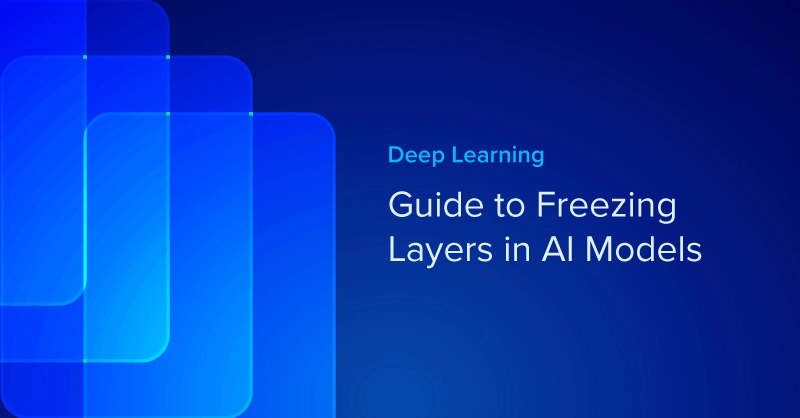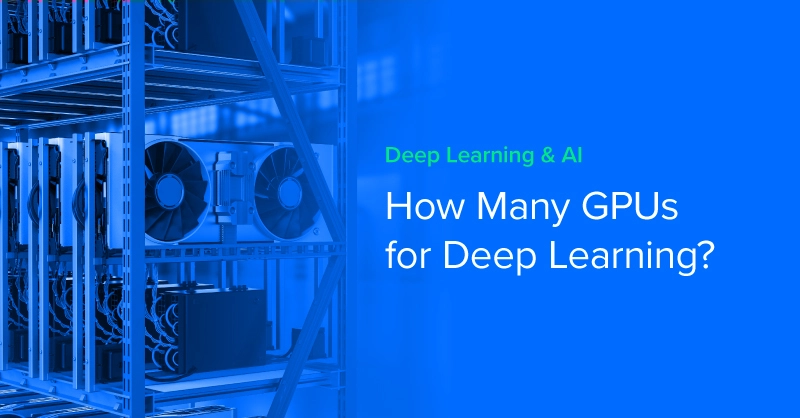
Introduction
High-speed networking plays a crucial role in high-performance computing (HPC) and artificial intelligence (AI) workloads. These applications demand rapid data transfer and low latency to maximize processing power. Ethernet and InfiniBand stand out as two dominant interconnect technologies in this space. This blog aims to help you evaluate which technology is the right fit for your compute infrastructure.
What Is Ethernet?
Ethernet is a widely used networking protocol for connecting devices in local area networks (LANs) and data centers, offering scalable bandwidth and broad compatibility. Initially developed for office LANs, Ethernet has grown into the standard interconnect for enterprise and cloud environments. Its widespread adoption drives rapid innovation, with modern implementations supporting speeds of 100GbE, 200GbE, and even 400GbE. Ethernet ports come in various types such as RJ45, SFP, SFP+, QSFP+, and QSFP28, each designed for specific network architectures and data transfer needs. RJ45 is the most common whereas SFP is mainly used in the data center.
Ethernet’s flexibility makes it well-suited for a variety of workloads, including virtualization, cloud computing, and large-scale storage networks. Advanced features such as Remote Direct Memory Access over Converged Ethernet (RoCE) and integration with Data Processing Units (DPUs) like NVIDIA BlueField further extend its capabilities for high-performance applications.
When to Use Ethernet
Ethernet is a solid choice for general-purpose workloads where cost-efficiency is a priority. It provides seamless data center interoperability due to its widespread adoption and compatibility with existing hardware and software architectures. Cloud-native applications can also benefit from Ethernet, especially when paired with NVIDIA BlueField DPUs (data processing units) which offload networking, storage, and security tasks to dedicated hardware.
Use Ethernet when:
- Deploying virtualized workloads, microservices, or containerized apps
- Used for controlling other nodes in your computing infrastructure
- Monitoring hardware resources
- Job scheduling
- Cost and scalability is prioritized across many racks and/or locations
- When deployment uses standard TCP/IP protocols and don’t need ultra-low latency
- You need compatibility with cloud and hybrid environments
What Is InfiniBand?
InfiniBand is a high-speed, low-latency interconnect technology designed specifically for high-performance computing (HPC) and AI workloads. It provides native support for Remote Direct Memory Access (RDMA), enabling direct communication between memory across nodes with minimal CPU involvement. This design significantly enhances data throughput and reduces latency in demanding compute environments.
InfiniBand delivers exceptional bandwidth across several generations, including FDR (14.0625 GB/s per lane), EDR (25 GB/s), HDR (50 GB/s), and NDR (100 GB/s). It is a leading choice in AI model training, scientific simulations, and large-scale clusters. Its software ecosystem—featuring tools like OpenMPI, Slurm, and GPUDirect RDMA—further optimizes performance for tightly coupled workloads.
When to Use InfiniBand
InfiniBand excels in environments that demand ultra-low latency, high bandwidth, and minimal CPU overhead. It is purpose-built for HPC workloads, AI/ML training clusters, and large-scale simulations, specifically when workloads require or benefit from inter-node communication. InfiniBand includes native RDMA, advanced congestion control, and better scalability across multi-node deployments versus Ethernet.
Use InfiniBand when:
- Running workloads across multiple compute nodes
- Training large-scale AI/ML models
- Running scientific simulations like CFD, weather modeling, or molecular dynamics
- Low-latency is a priority for tightly coupled HPC workloads ****
- Workload requires high throughput and predicable network performance under sustained load
- Using MPI-based parallel computing frameworks (found in CFD, Molecular Dynamics, and more)
- You compute hardware in your cluster includes systems that utilize NVIDIA NVLink.
- NVIDIA H200 NVL, NVIDIA HGX H200, NVIDIA HGX B200, and others already utilize low latency GPU-to-GPU that can be maximized when paired with low latency networking across the computing infrastructure
Deploying InfiniBand and Ethernet?
Ethernet and InfiniBand definitly coexist within the same data center architecture, and they often do in many high-performance environments. These mixed-fabric architectures allow organizations to balance cost, performance, and compatibility by assigning each network fabric to specific roles based on its strengths.
Hybrid Deployment Strategy
A common approach is to split responsibilities between control and compute traffic. Most servers already have networking built into the platform and can benefit from and additional Infiniband NIC.
- Ethernet handles the control plane or head node for system monitoring, job scheduling, data I/O, and management traffic. Its broad compatibility with standard tools make it ideal for general infrastructure functions.
- InfiniBand will connect the compute nodes with ultra-low-latency, high-bandwidth links ideal for tightly-coupled parallel processing. The higher performance speeds up the time to result for data intensive workloads.
Dual-NIC Server Design
Sometimes, deployment requires servers to equip two network interface cards (NICs): one for ethernet, and one for InfiniBand. The InfiniBand NIC handles RDMA, MPI traffic, and inter-node data movement for HPC jobs. The Ethernet NIC connects to storage, orchestration services, cloud gateways, or administrative interfaces that need an extra oomph in speed only a dedicated NIC can provide. This setup is particularly useful in:
- AI training clusters using GPUDirect RDMA over InfiniBand and NFS or S3 over Ethernet
- HPC clusters with that handle large data transfer traffic over Ethernet and MPI application traffic over InfiniBand
- Hybrid cloud environments, where Ethernet enables external access and InfiniBand handles local compute tasks
Conclusion
Ethernet and InfiniBand offer distinct advantages and disadvantages. Ethernet provides cost-effectiveness and broad compatibility, whereas InfiniBand delivers unparalleled performance for demanding workloads. Choosing the right network fabric depends on your specific workload requirements, scale, and budget.
| Feature | Ethernet | InfiniBand |
| Latency | Higher | Lower |
| Bandwidth | Up to 800GbE | Up to 800Gbps |
| CPU Overhead | Higher | Lower |
| RDMA Support | Yes (RoCE) | Native |
| Scalability | High | Very high |
| Cost | Lower | Higher |
| Ecosystem | Cloud, enterprise, edge | HPC, AI clusters |
Mixed fabrics offer flexibility but introduces network routing, monitoring, and tuning complexity. Proper planning is necessary to getting the most value.
Exxact can offering assistance with fabric design or optimization for your specific use cases. Exxact is capable of full rack integration with professional network mapping for single and multi-node clusters built with your workload in mind. Contact us today!

InfiniBand vs Ethernet in the Data Center
Introduction
High-speed networking plays a crucial role in high-performance computing (HPC) and artificial intelligence (AI) workloads. These applications demand rapid data transfer and low latency to maximize processing power. Ethernet and InfiniBand stand out as two dominant interconnect technologies in this space. This blog aims to help you evaluate which technology is the right fit for your compute infrastructure.
What Is Ethernet?
Ethernet is a widely used networking protocol for connecting devices in local area networks (LANs) and data centers, offering scalable bandwidth and broad compatibility. Initially developed for office LANs, Ethernet has grown into the standard interconnect for enterprise and cloud environments. Its widespread adoption drives rapid innovation, with modern implementations supporting speeds of 100GbE, 200GbE, and even 400GbE. Ethernet ports come in various types such as RJ45, SFP, SFP+, QSFP+, and QSFP28, each designed for specific network architectures and data transfer needs. RJ45 is the most common whereas SFP is mainly used in the data center.
Ethernet’s flexibility makes it well-suited for a variety of workloads, including virtualization, cloud computing, and large-scale storage networks. Advanced features such as Remote Direct Memory Access over Converged Ethernet (RoCE) and integration with Data Processing Units (DPUs) like NVIDIA BlueField further extend its capabilities for high-performance applications.
When to Use Ethernet
Ethernet is a solid choice for general-purpose workloads where cost-efficiency is a priority. It provides seamless data center interoperability due to its widespread adoption and compatibility with existing hardware and software architectures. Cloud-native applications can also benefit from Ethernet, especially when paired with NVIDIA BlueField DPUs (data processing units) which offload networking, storage, and security tasks to dedicated hardware.
Use Ethernet when:
- Deploying virtualized workloads, microservices, or containerized apps
- Used for controlling other nodes in your computing infrastructure
- Monitoring hardware resources
- Job scheduling
- Cost and scalability is prioritized across many racks and/or locations
- When deployment uses standard TCP/IP protocols and don’t need ultra-low latency
- You need compatibility with cloud and hybrid environments
What Is InfiniBand?
InfiniBand is a high-speed, low-latency interconnect technology designed specifically for high-performance computing (HPC) and AI workloads. It provides native support for Remote Direct Memory Access (RDMA), enabling direct communication between memory across nodes with minimal CPU involvement. This design significantly enhances data throughput and reduces latency in demanding compute environments.
InfiniBand delivers exceptional bandwidth across several generations, including FDR (14.0625 GB/s per lane), EDR (25 GB/s), HDR (50 GB/s), and NDR (100 GB/s). It is a leading choice in AI model training, scientific simulations, and large-scale clusters. Its software ecosystem—featuring tools like OpenMPI, Slurm, and GPUDirect RDMA—further optimizes performance for tightly coupled workloads.
When to Use InfiniBand
InfiniBand excels in environments that demand ultra-low latency, high bandwidth, and minimal CPU overhead. It is purpose-built for HPC workloads, AI/ML training clusters, and large-scale simulations, specifically when workloads require or benefit from inter-node communication. InfiniBand includes native RDMA, advanced congestion control, and better scalability across multi-node deployments versus Ethernet.
Use InfiniBand when:
- Running workloads across multiple compute nodes
- Training large-scale AI/ML models
- Running scientific simulations like CFD, weather modeling, or molecular dynamics
- Low-latency is a priority for tightly coupled HPC workloads ****
- Workload requires high throughput and predicable network performance under sustained load
- Using MPI-based parallel computing frameworks (found in CFD, Molecular Dynamics, and more)
- You compute hardware in your cluster includes systems that utilize NVIDIA NVLink.
- NVIDIA H200 NVL, NVIDIA HGX H200, NVIDIA HGX B200, and others already utilize low latency GPU-to-GPU that can be maximized when paired with low latency networking across the computing infrastructure
Deploying InfiniBand and Ethernet?
Ethernet and InfiniBand definitly coexist within the same data center architecture, and they often do in many high-performance environments. These mixed-fabric architectures allow organizations to balance cost, performance, and compatibility by assigning each network fabric to specific roles based on its strengths.
Hybrid Deployment Strategy
A common approach is to split responsibilities between control and compute traffic. Most servers already have networking built into the platform and can benefit from and additional Infiniband NIC.
- Ethernet handles the control plane or head node for system monitoring, job scheduling, data I/O, and management traffic. Its broad compatibility with standard tools make it ideal for general infrastructure functions.
- InfiniBand will connect the compute nodes with ultra-low-latency, high-bandwidth links ideal for tightly-coupled parallel processing. The higher performance speeds up the time to result for data intensive workloads.
Dual-NIC Server Design
Sometimes, deployment requires servers to equip two network interface cards (NICs): one for ethernet, and one for InfiniBand. The InfiniBand NIC handles RDMA, MPI traffic, and inter-node data movement for HPC jobs. The Ethernet NIC connects to storage, orchestration services, cloud gateways, or administrative interfaces that need an extra oomph in speed only a dedicated NIC can provide. This setup is particularly useful in:
- AI training clusters using GPUDirect RDMA over InfiniBand and NFS or S3 over Ethernet
- HPC clusters with that handle large data transfer traffic over Ethernet and MPI application traffic over InfiniBand
- Hybrid cloud environments, where Ethernet enables external access and InfiniBand handles local compute tasks
Conclusion
Ethernet and InfiniBand offer distinct advantages and disadvantages. Ethernet provides cost-effectiveness and broad compatibility, whereas InfiniBand delivers unparalleled performance for demanding workloads. Choosing the right network fabric depends on your specific workload requirements, scale, and budget.
| Feature | Ethernet | InfiniBand |
| Latency | Higher | Lower |
| Bandwidth | Up to 800GbE | Up to 800Gbps |
| CPU Overhead | Higher | Lower |
| RDMA Support | Yes (RoCE) | Native |
| Scalability | High | Very high |
| Cost | Lower | Higher |
| Ecosystem | Cloud, enterprise, edge | HPC, AI clusters |
Mixed fabrics offer flexibility but introduces network routing, monitoring, and tuning complexity. Proper planning is necessary to getting the most value.
Exxact can offering assistance with fabric design or optimization for your specific use cases. Exxact is capable of full rack integration with professional network mapping for single and multi-node clusters built with your workload in mind. Contact us today!


.jpg?format=webp)

